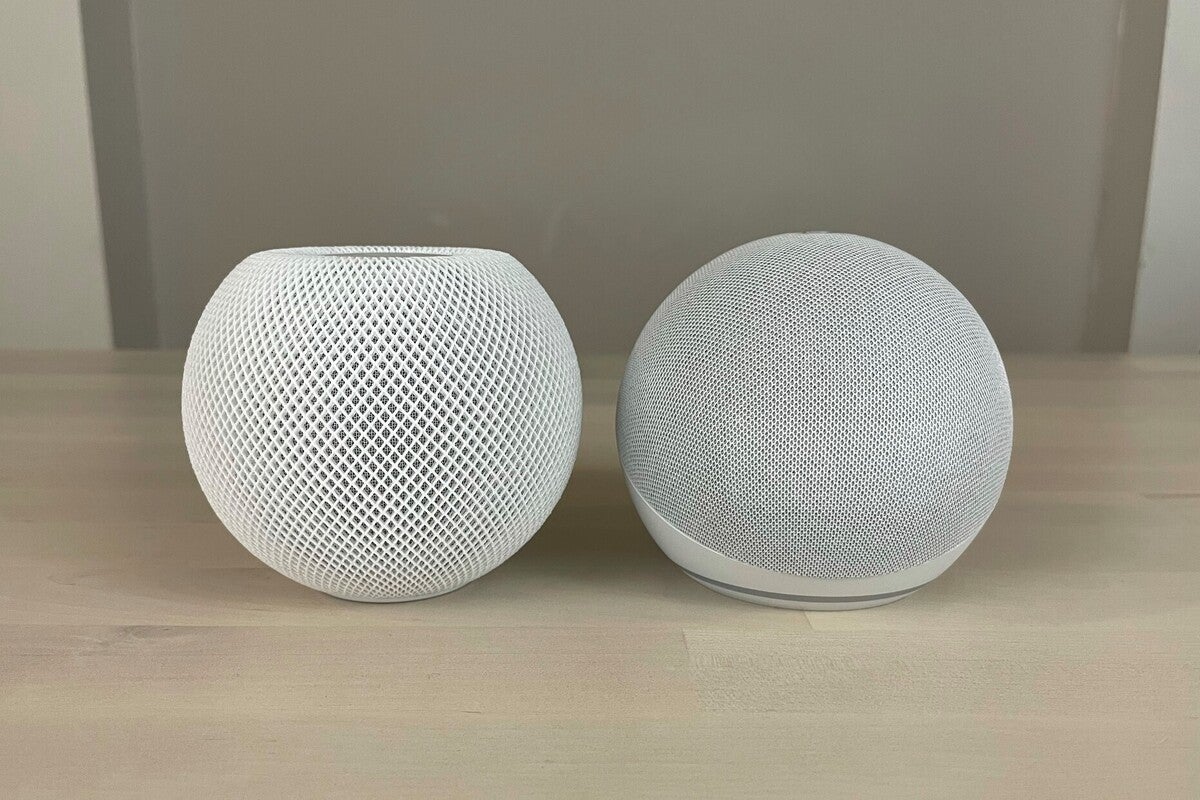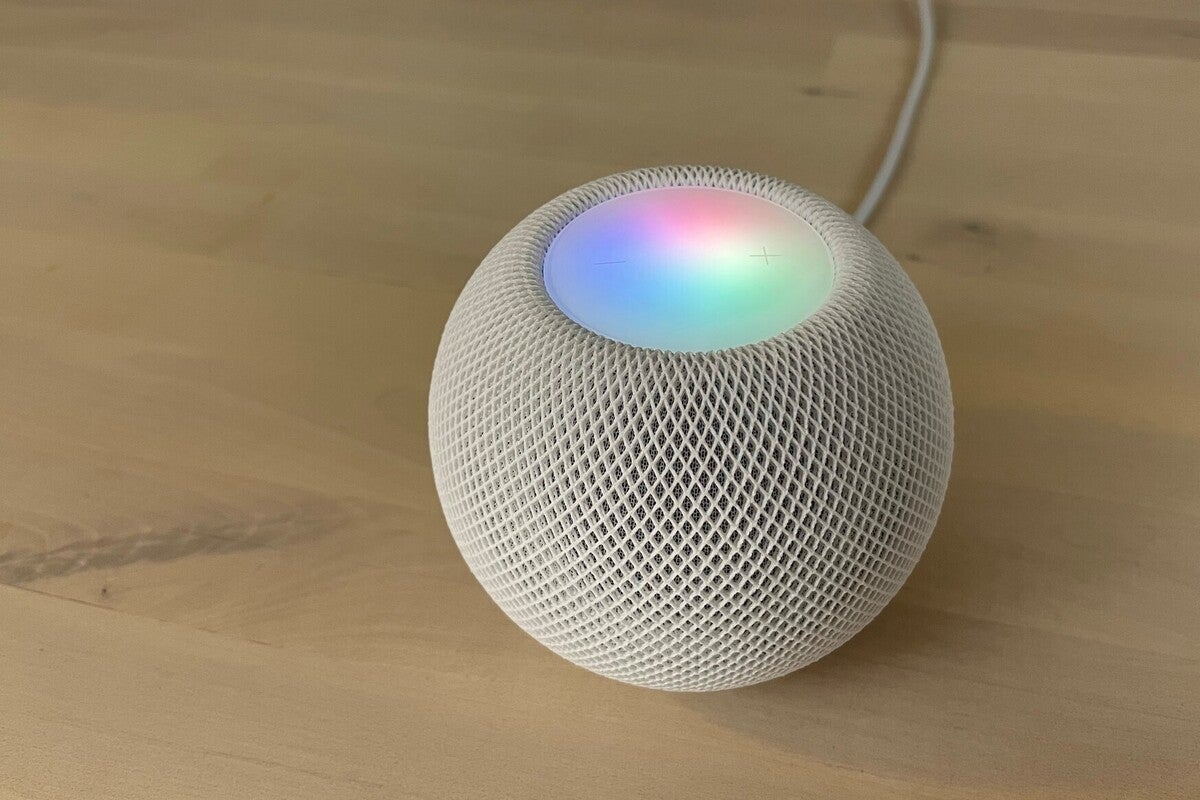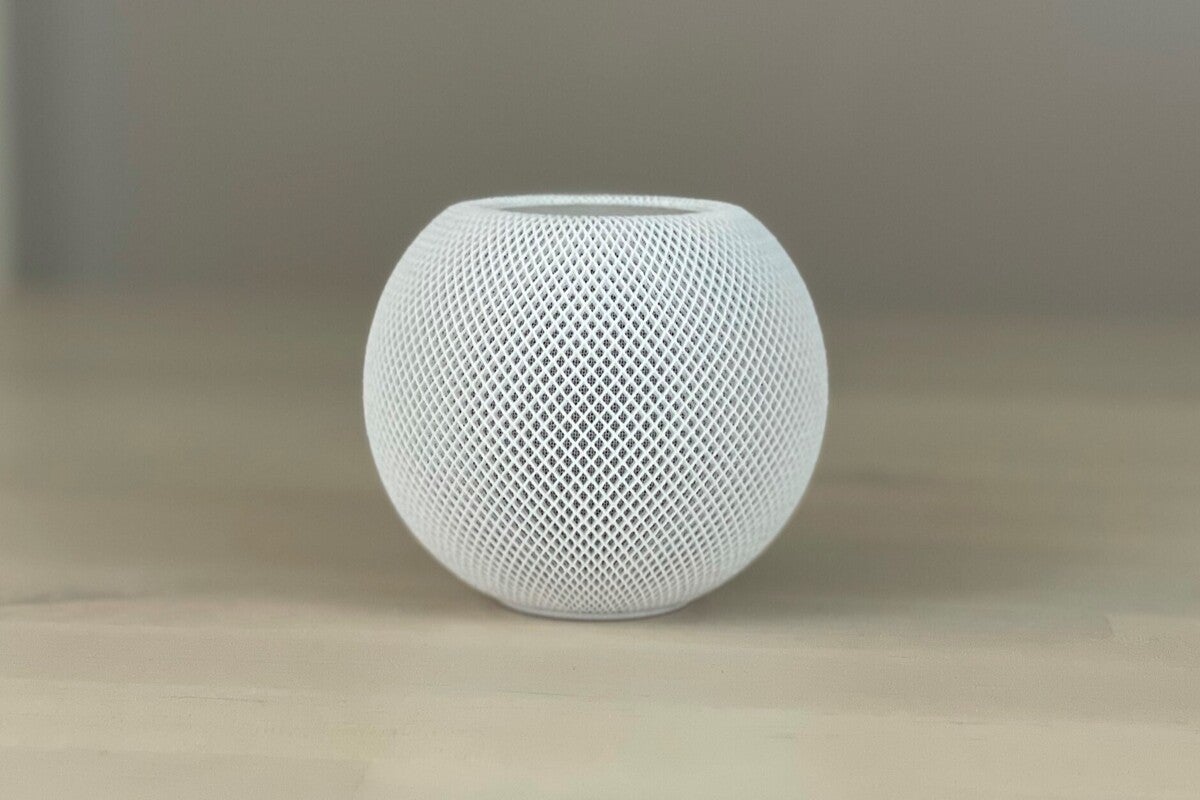If the HomePod Mini were $50 rather than $99, we’d really have something.
Ben Patterson/IDG
Today’s Best Tech Deals
Picked by TechHive’s Editors
Top Deals On Great Products
Picked by Techconnect’s Editors
Show More
Apple’s new, cheaper HomePod is a tough smart speaker to nail down. On the one hand, the HomePod Mini boasts impressive audio quality for its size. On the other hand, it doesn’t sound as good as other smart speakers in its price range. The HomePod Mini also has a Thread radio that lets it act as a smart home hub, but for now, there are only a few Thread-enabled smart devices available to control. And while Apple’s new Intercom feature makes for an easy way to broadcast messages to household members, it doesn’t allow for two-way calling.
Now, if you’re a dedicated Apple user and you’ve been waiting for a more affordable Siri-powered smart speaker than the $300 HomePod, the $99 HomePod Mini is your best—and only—bet. But if you’re open to Alexa or Google Assistant, you can find cheaper entry-level options (such as the $50 Amazon Echo Dot and Google Nest Mini), as well as better-sounding speakers (like the $99 Google Nest Audio) and better smart home-oriented devices (the $99 Echo with its Zigbee smart home hub).
This review is part of TechHive’s coverage of the best smart speakers, where you’ll find reviews of competing products, plus a buyer’s guide to the features you should consider when shopping for this type of product.
Design
Spheres are in when it comes to the latest smart speakers. The redesigned Amazon Echo and Echo Dot both revealed their spherical designs back in September, and now comes the spherical HomePod mini—well, nearly spherical, save for its flattened, touch-enabled top.
Besides being somewhat matchy-matchy in terms of shape, the HomePod mini and fourth-gen Echo Dot are almost exactly the same size, with the 3.3-inch HomePod mini a tad shorter but precisely the same width as the latest Dot. Indeed, when the HomePod Mini and new Echo Dot are sitting side-by-side, they look remarkably similar, save for the Mini’s flat top.
 Ben Patterson/IDG
Ben Patterson/IDGCan you spot the HomePod Mini in this picture?
Available in white and space gray, the HomePod mini has a fabric covering that extends to the edge of the speaker’s touch-sensitive top panel, while a rubberized pad at the bottom keeps the Mini firmly in place.
It’s worth noting that the HomePod Mini’s six-foot braided power cable is “captive,” meaning that it’s permanently attached. The cable terminates in a male USB-C connector, and a chunky 20-watt power adapter is included; fortunately, the adapter is designed to jut out from the outlet, meaning that nearby plugs are still accessible.
Buttons and interfaces
Similar to the bigger HomePod, the HomePod Mini’s top, backlit touchpad has “+” and “-” icons, and the multicolored backlighting glows during music playback and pulses when you’re chatting with Siri. You can tap the “+” or “-” icons to adjust the volume, tap once to play or pause music, or double-tap to skip, while touching and holding the touchpad summons Siri.
A physical control that’s conspicuously missing from the HomePod Mini is a mic mute button. Of course, you can just say, “Hey Siri, stop listening” if you want some privacy, and then press and hold the top of the Mini to summon Siri again (at which point you can ask her to turn “Hey Siri” back on). But even if you do ask Siri to stop listening, the HomePod Mini lacks a visual cue to confirm that its microphone is off. By way of comparison, both Amazon’s Echo speakers and Google’s Nest speakers have mic mute buttons and switches (respectively), and both have lights that glow (red for Echo speakers, orange for Nest) when their mics have been turned off.
 Ben Patterson/IDG
Ben Patterson/IDGThe HomePod Mini has illuminated touch controls on top, but no physical mic mute button.
Similar to most of Google’s Nest speakers, the HomePod Mini lacks a 3.5mm audio jack for connecting an external speaker; unlike Nest (and Echo) speakers, however, the Mini can’t send audio to a Bluetooth speaker, nor can you designate a wireless speaker as a “preferred” playback option for the Mini. Now, given the HomePod Mini’s solid audio quality (which we’ll detail a bit later), one could argue that there’s no need for a “preferred” speaker setting, but still, it’s worth mentioning.
Setup
Getting the HomePod Mini set up on your home network is dead simple, and for me, it was over in less than five minutes.
Once I plugged in the speaker, I simply held my iPhone close to it (you’ll need to make sure you have both Wi-Fi and Bluetooth enabled on your iOS device), and within seconds a “HomePod Mini” pop-up appeared on my iPhone’s display, complete with a “Set Up” button.
Next, you’ll iOS device will prompt you to designate the room in your home where the speaker will reside (“Master Bedroom,” “Office,” “Kitchen,” etc.), as well as whether you’d like to enable “Personal Requests,” which allow you or others in your home (Siri can recognize the voices of up to six family members) to check calendar events, send iMessages, set reminders, write notes in the Notes app, and so on. Finally, you’ll be asked to accept Apple’s terms and conditions, as well as transfer your Wi-Fi and iCloud settings.
Siri voice commands and HomeKit
Powered by Siri, Apple’s nine-year-old voice assistant, the HomePod Mini can respond to a wide variety of queries (“Hey Siri, how’s the weather today?”) and commands (“Hey Siri, send a message to my wife”), and like Alexa and Google Assistant, it can be a friendly, obedient, and impressively accurate companion. On the HomePod Mini, Siri responded relatively quickly to my requests, and its four far-field microphones were able to pick up my voice from across the room, even when I spoke in a quiet voice.
Siri on the HomePod Mini can also control smart devices that are compatible with HomeKit, Apple’s smart home platform. HomeKit doesn’t enjoy the wide degree of smart device support that Alexa and Google Assistant do; more than 100,000 smart devices support Alexa, while about 50,000 devices support Google Assistant. Apple hasn’t given a recent count for Siri’s smart device support. But many popular smart device manufacturers do support HomeKit, including Signify’s Philips Hue smart lighting brand, Anker’s EufyCam smart camera line, Logitech, Belkin’s Wemo brand, August, Yale, and Lutron. Like the full-size HomePod, the HomePod Mini works as a HomeKit “home hub,” allowing you to control your HomeKit devices even when you’re out of the house.
The HomePod Mini also supports Thread, a low-power, low-latency IoT protocol that’s backed by Apple, Google, Samsung, Qualcomm, and other tech titans. An IP-based standard that’s won accolades for its stability and emphasis on security, Thread has gotten off to a slow start since the initial “Thread Group” debuted in 2014, but its arrival on the HomePod Mini (which can act as a Thread “border router” that connects Thread-enabled smart devices to the internet) could help speed the protocol’s momentum. Smart device manufacturers such as Eve and Nanoleaf have already released products that work with Thread (I’ve been using Nanoleaf’s new, Thread-enabled A19 “Essential” bulb with the HomePod Mini, and it’s been working like a charm), and others are expected in the coming months. But compared to a wireless IoT protocol such as Zigbee, which enjoys wide support among smart home devices (and the $99 Amazon Echo comes with a built-in Zigbee hub), only a handful of smart devices work with Thread so far.
Communication
When it announced the HomePod Mini, Apple also unveiled Intercom, a new communications feature that lets you broadcast announcements to other HomePods, iOS devices, Apple Watches, AirPods, and even cars enabled with Apple’s CarPods system. (Curiously, Intercom doesn’t work with iMacs or MacBooks, or at least not yet.)
 Ben Patterson/IDG
Ben Patterson/IDGIntercom messages from the HomePod Mini (or the bigger HomePod) arrive as interactive pop-ups on an iPhone.
Using Intercom is simple. Just say, “Hey Siri, Intercom,” and then say whatever you want to broadcast to the iOS devices and HomePods connected to the Apple Home app. What happens next depends on the Apple device in question. iPhones and iPads, for example, will get a pop-up with a “play” button that lets you play back your Intercom announcement (you hear the speaker’s actual voice, not Siri’s), while HomePods, AirPods, and CarPlay devices will beep and play the message immediately.
By default, Intercom messages are sent to all supported Apple devices connected to the Apple Home app, but you can also ask Siri to send an announcement to a specific HomePod (“Hey Siri, tell downstairs that dinner is ready”). You can also ask Siri to reply to an Intercom announcement.
While Apple’s new Intercom feature makes for an easy way to ask Siri on the HomePad Mini to blast a message to Apple users in your home, the HomePod Mini doesn’t let you make two-way calls, or at least not without the help of an iPhone. You can ask Siri on a HomePod Mini to make a Facetime audio call, but when you do, it’s your iPhone that’s making the call, with the Mini basically acting as a speakerphone. Amazon Echo speakers, on the other hand, can natively “drop in” to other Echo speakers for two-way calling, and you can even ask Alexa to place a (free) VoIP call to any phone number in the U.S., Canada, or Mexico. Nest speakers and displays, meanwhile, let you make two-way audio or video calls using the Google Duo calling app, no phone required.
Music and audio
Understandably, the $99 HomePod Mini lacks the impressive driver array of the $300 HomePod. Instead of the HomePod’s eight drivers (including one woofer and seven beam-forming tweeters), the HomePod Mini makes do with a single full-range, neodymium magnet-powered dynamic driver, plus a pair of force-cancelling passive radiators. An acoustic waveguide helps to spread audio from the down-firing drive in all directions, while Apple’s S5 chip (the same as you’ll find in an Apple Watch) analyzes your tunes and makes real-time adjustments to the sound.
So, how does the HomePod Mini sound? While it’s obviously a downgrade compared to the bigger HomePod, the Mini version sounds surprisingly full-bodied and detailed for its size. Queuing up Carlos Kleiber’s legendary rendition of Beethoven’s Fifth Symphony on Apple Music, the strings and the brass sounded clean, crisp and distinct, while the driving timpani sounded satisfyingly punchy. Jumping over to “The Ghost of Tom Joad” by Bruce Springsteen, The Boss’s vocals and reedy harmonica sounded textured and alive, while the rising synthesizer felt warm and relatively deep.
Compared to the OK-but-not-amazing audio of the fourth-gen Echo Dot, the HomePod Mini sounds deeper and richer, with precise bass that avoids the muddiness that plagues the Echo Dot. Put another way, the Echo Dot merely lets you hear music, while the HomePod Mini heads into true enjoyment territory.
Of course, the Echo Dot costs half as much as a HomePod Mini (and even less when the Dot’s on sale, which it generally is), so it’s not that surprising that the cheaper Amazon speaker can’t keep up in the audio department. A more apt comparison would be with Google’s new Nest Audio, a $99 smart speaker that ups the ante with a tweeter and a mid-woofer, both in a front-firing configuration. Listening to the two speakers side-by-side, the Nest Audio’s sound clearly wins out. Not only does the Nest Audio sound even clearer and richer than the HomePod Mini, it also sounds quite a bit bigger and more powerful, and you can crank its volume considerably louder. Purely from a sound perspective, the Nest Audio remains the smart speaker to beat—at least at the $99 price point.
As with the Nest Audio, the HomePod Mini can be connected to a second Mini to create a stereo pair; because I only had one HomePod Mini available, I wasn’t able to test stereo pairing. The HomePod Mini also (of course) supports AirPlay 2, good for using the Mini in multi-room audio setups or for casting audio to the speaker from an Apple device. And thanks to Apple’s ultra-wideband U1 chip, you can “hand off” music from the HomePod Mini to your iPhone (or vice versa) when the two devices are in close proximity.
In terms of music streaming, the HomePod Mini supports Apple Music, iCloud Music Library, Apple Podcasts, streaming radio stations such as TuneIn, iHeartRadio, and Radio.com. But while Apple just announced that the HomePod Mini and the larger HomePod finally support third-party music streaming services, Pandora is the only streaming service that’s signed on so far, and there’s no ETA on such competitors as Amazon Music, Tidal, Deezer, Qobuz, YouTube Music, or Spotify. For now, if you want to stream tracks from those services on the HomePod Mini, you’ll have to cast them from another device via AirPlay.
Bottom line
If Apple’s new, smaller HomePod cost the same as a $50 Amazon Echo Dot or a Google Nest Mini, I’d be calling it the new champ (albeit with caveats) in the entry-level smart speaker market. But at $99, the HomePod Mini falls short to the similar-priced Google Nest Audio in terms of sound quality, and it can’t match the smart home skills of the $99 Amazon Echo. And while the HomePod Mini’s new Intercom feature and added support for third-party music services are both steps in the right direction, Amazon and Google still (and for now) have Apple’s HomePod ecosystem beat in the communication and music departments. Again, if you’re dead-set on sticking with Apple and Siri, the HomePod Mini makes for a solid choice, and what it does, it does well. But if you’re willing to dally with Alexa or Google Assistant, there are better values out there.
Note: When you purchase something after clicking links in our articles, we may earn a small commission. Read our affiliate link policy for more details.
If you’re a dedicated Apple and Siri user, the HomePod Mini makes for a solid choice, but if you’re willing to try Alexa or Google Assistant, there are better values out there.
Pros
- Impressive audio quality for its size
- Easy setup
- Works as a Thread border router
- New “Intercom” feature lets you broadcast messages to family members
Cons
- No physical mic mute control
- Intercom doesn’t support two-way calls
- Supports only one third-party music services (for now)
- We’ve heard better-sounding smart speakers in the Mini’s price range
Ben has been writing about technology and consumer electronics for more than 20 years. A PCWorld contributor since 2014, Ben joined TechHive in 2019, where he covers smart home and home entertainment products.


